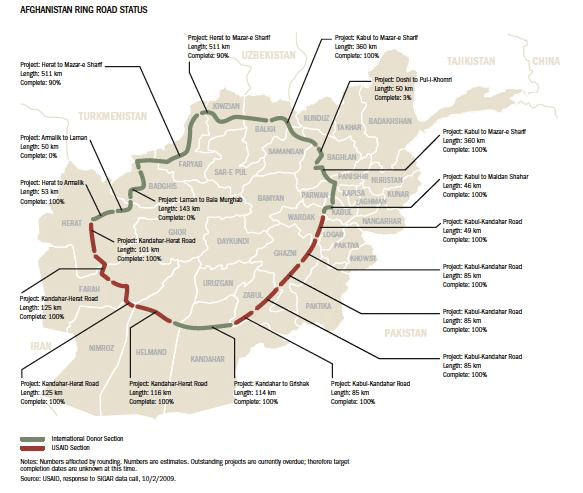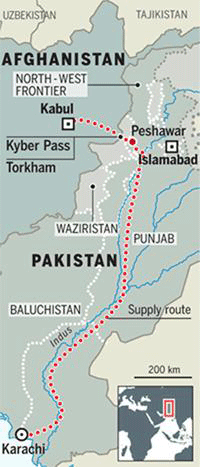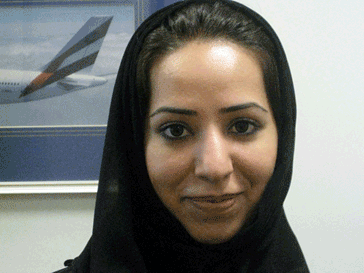Afghan Cargo Gets Dubai Lift
 |
As troop levels ramp up
in Afghanistan so do cargo flights from various gateways.
Right now Dubai and all other Middle East
gateways are moving ever increasing amounts of air cargo brought into
the region by carriers from all over the world to Kabul and elsewhere.
During 2009, buildup activity has been
steady but with a recent spike, activity here is expected to go over
the top in coming months.
According to statistics from the U.S.
Air Forces Central Command combined air Operations Center in Southwest
Asia, cargo and passenger movements for January and February remained
fairly steady at the "pre-surge" state for Operation Enduring
Freedom.
In January, mobility aircraft moved 16,450
tons of cargo and 26,600 passengers while 16,720 tons of cargo and 24,200
passengers were moved in February.
By March however, the Operation Enduring
Freedom troop surge pace picked up dramatically with nearly a 75 percent
increase in cargo and passenger movement into Afghanistan.
In March, 22,100 tons of cargo and 32,400
passengers were moved in the Operation Enduring Freedom area of responsibility.
Since March, that pace has continued to
grow and the cargo industry continues to build itself to try and help
meet demand.
 Between
April and September, more than 137,500 tons of cargo moved for Operation
Enduring Freedom. Between
April and September, more than 137,500 tons of cargo moved for Operation
Enduring Freedom.
With 30,000 additional troops, the demand
for airfreight is expected to increase, thus bringing in new challenges
for commercial carriers worldwide.
“Currently, the problematic and
time-consuming issues are the landing permissions in the airbases and
inadequate offloading (no high loaders) facilities for commercial carriers,”
says Lionel Smith, (left) president of Air Cargo Integrators (ACI) based
in Dubai.
“This is already causing a bottleneck
situation, whereby military flights are a priority and PPR’s for
commercial flights are approved as per the slots available. “Thereafter,
the PPR’s must coordinate with the handling agents’ timings
due to time constraints.”
Lionel Smith notes:
“From Dubai ACI now operates two
frequencies per week to Kabul, using B747 or MD-11s.
“We started utilizing western equipment
earlier this year in May 2009, as opposed to the IL-76, the single aircraft
we flew for many years into the theatre.
“But now in addition to our regular
Kabul weekly flights, we are also operating four frequencies weekly,
two into Bagram AB and two into Kandahar AB either using a A300 or an
IL-76.
"Our SPA partners such as Etihad,
Lufthansa, Cargolux and Coyne support us 100% with their loads into
Afghanistan.”
With the Troop surge ACI anticipates additional
frequencies in 2010.
“ACI is 100% committed to the Afghan
developmental process,” Lionel Smith says.
“We have done and delivered our
best services since February 2002 right until today and will continue
doing so, to support the Afghani’s and the International Community
there,” Smith declared.
Meantime inside Afghanistan itself, air
cargo will continue to play a vital role.
 There
the roads are too dangerous to convoy supply trucks and in many cases
bandits and hostiles make over the road impossible most of the time. There
the roads are too dangerous to convoy supply trucks and in many cases
bandits and hostiles make over the road impossible most of the time.
Apart from attacks on convoys and freight
vehicles, individual passengers aren’t even safe – rumor
has it, the Taliban has agents at bus stations and in the taxi fleets
willing to identify good targets for kidnapping.
In best-case scenarios during this year
2009- even in good weather it takes an average of three weeks for a
truck to move from Bagram Air Field, where cargo flights arrive from
the U.S. and Europe to Kandahar, the staging base for allied forces
in southern Afghanistan.
In winter, a road convoy that can get
through can take twice that long, and makes an attractive target, both
for attacks and shake-downs for protection money.
A key element of the Afghanistan cargo
support strategy is the development of the Northern Distribution Network.
This initiative provides additional routes to move material to troops
on the ground through the South Caucasus and Central and South-Asian
states.
Still geography, the lack of extensive
complementary transportation links (Afghanistan has no railroad infrastructure!)
and minimal security on them will continue to be a major challenge looking
ahead at the U.S. military effort in Afghanistan.
Looking at the broader picture, supply
chains into Iraq for example are operated from 'safe havens' for the
U.S. in Jordan (where Aqaba has been used), Kuwait and Turkey for activities
in the North.
In Afghanistan there is nothing comparable
- certainly not on the all-important frontier between Afghanistan &
Pakistan.
The staging areas for the run through Pakistan’s FATA region have
become both bottlenecks for cargo and magnets for insurgent attacks,
including a three-day assault on Peshawar’s logistics terminal
in December 2008 that destroyed over 170 vehicles.
The insecurity in that area has pushed
the main route from Karachi further east, exacerbating lag times and
putting more pressure on limited road resources.
In Afghanistan, the expansion of commercial
airlines has not been met with a growth in air traffic management capacity,
and the Afghan civil system struggles with the volumes it currently
carries.
In Iraq, it is widely felt that there
have been some important misjudgments about rehabilitating the Iraq
gateway including granting operating concessions there, but at this
point at least it looks doubtful that comparable interests are in place
at Kabul.
Moreover, the surface transportation of
Afghanistan is not remotely similar—in condition, extent or security,
to what exists around Baghdad and Fallujah.
Even the ring road, the main artery for
ground transport in Afghanistan remains unfinished, and the completed
sections are constantly degraded by IEDs, insurgent attacks and harsh
weather. Outside the ring road, the Afghan road network is even farther
from completion.
|
Total Road (km) |
Completed Road (km) |
Regional Roads (Ring Road) |
3,363 |
2,496 |
National Roads |
4,958 |
1,112 |
Provincial Roads |
10,000 |
9,528 |
Rural Roads |
17,000 |
1,000 |
.
As the Afghan epic unfolds, it is apparent
the outcome will depend on some factors not yet guaranteed, but needed.
More and more air cargo will be required for supply but also support
factors in country will need to be brought forward.
Geoffrey
|



 State-owned
Air China is overseeing the commercial activities of Shenzhen Airlines
after Li Zeyuan, (left)the major shareholder of the Shenzhen-based carrier
is being investigated by police for alleged economic crimes.
State-owned
Air China is overseeing the commercial activities of Shenzhen Airlines
after Li Zeyuan, (left)the major shareholder of the Shenzhen-based carrier
is being investigated by police for alleged economic crimes. 

 Between
April and September, more than 137,500 tons of cargo moved for Operation
Enduring Freedom.
Between
April and September, more than 137,500 tons of cargo moved for Operation
Enduring Freedom. There
the roads are too dangerous to convoy supply trucks and in many cases
bandits and hostiles make over the road impossible most of the time.
There
the roads are too dangerous to convoy supply trucks and in many cases
bandits and hostiles make over the road impossible most of the time.

 Lufthansa
Cargo’s long time Sales Director South East Asia and Australia,
Gabriela Ahrens, has taken on a new assignment by becoming Executive
Vice President Sales and Products at Jade Cargo International as of
December 1.
Lufthansa
Cargo’s long time Sales Director South East Asia and Australia,
Gabriela Ahrens, has taken on a new assignment by becoming Executive
Vice President Sales and Products at Jade Cargo International as of
December 1. 







